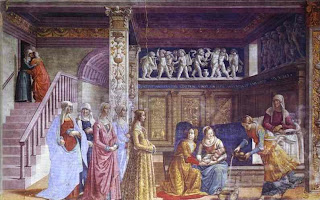
A great use of gestalt would be in the artwork created by Romare Bearden titled The Prevalence of Ritual: Baptism in 1964. This artwork is based on the art of Cubism, where the subject matter is basically African-American. The fractured image shows baptism in this work. The pieces and figures that are depicted in this artwork are pieced together by using grouping of textures and different contrasts. The viewer can get a great sense of depth with the use of various textures in the piece. Bearden takes information and energy into a single image and then combines the various shapes to compose an entire scene.By using various contrasts by using high key and low key components of black, white, and gray tones, the artist gave the viewer a sense of depth. The background has more black tones to create the illusion of an image that is further away from you. He uses more shade, which represents more black than white. There is a significant value pattern that is used within this artwork, where white, gray, and black are arranged in variations in light and dark areas. By using the visually emphasized techniques that he chose, the high value contrast definitely bring the front images closer to you, while the lesser contrast stayed back, which is represented as the background of the artwork.






